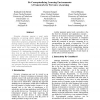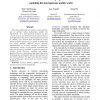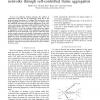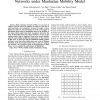1238 search results - page 179 / 248 » Capacity, Delay and Mobility in Wireless Ad-Hoc Networks |
PERCOM
2005
ACM
15 years 9 months ago
2005
ACM
Pervasive eLearning requires a novel media perspective on learning objects. Instead of viewing handhelds or smart phones as minimized PCs we would like to propose a perspective on...
IC
2001
14 years 11 months ago
2001
The wide proliferation of wireless systems and the use of software radio technologies enables the employment of a heterogeneous network. In this concept services are delivered via...
109
click to vote
SOCIALCOM
2010
14 years 7 months ago
2010
Smart phones can collect and share Bluetooth co-location traces to identify ad hoc or semi-permanent social groups. This information, known to group members but otherwise unavailab...
VTC
2006
IEEE
15 years 3 months ago
2006
IEEE
— In multi-hop wireless networks, the number of supportable VoIP calls can be surprisingly small due to the increased spatial interference. To mitigate the interference, voice fr...
106
click to vote
PIMRC
2010
IEEE
14 years 7 months ago
2010
IEEE
Delay Tolerant networks (DTNs) are one type of wireless networks where the number of nodes per unit area is small and hence the connectivity between the nodes is intermittent. In t...




